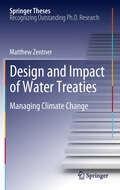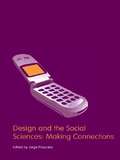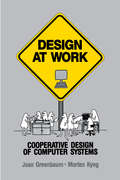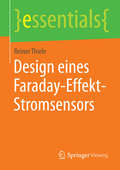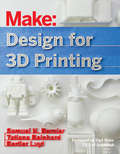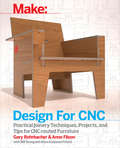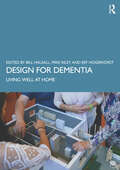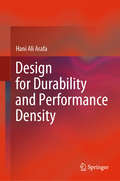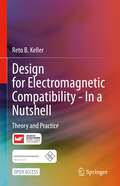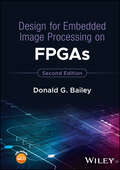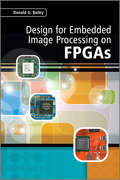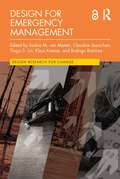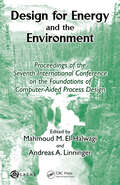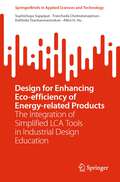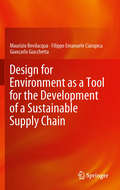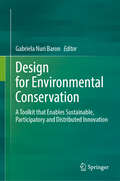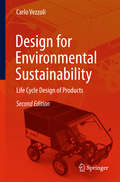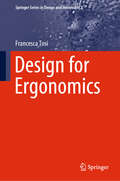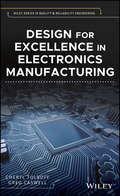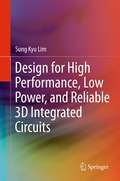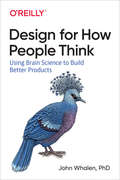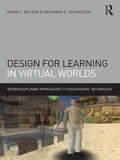- Table View
- List View
Design and impact of water treaties
by Matthew ZentnerThis study presents a unique way to utilize the existing literature to explain the success of treaties in managing hydrologic stress. Literature-derived core concepts are summarized as seven treaty mechanisms categories (specificity, uncertainty management, enforcement, communications, flexibility, integrativeness, and scale) and are hypothesized as important for shaping the institutional resiliency of a treaty. Treaty design is shown to have a relevant and important role in shaping basin management so that nations may better achieve their goals in a changing climate.
Design and the Social Sciences: Making Connections
by Jorge FrascaraThe social sciences have a distinctive contribution to make to the understanding and handling of design issues, both in product and systems design and in the design of the built environment. The role of cognitive psychology, particularly ergonomics, to the design process has traditionally been well appreciated. Because it provides important insight
Design at Work: Cooperative Design of Computer Systems
by Joan GreenbaumThe contributors to this important volume begin with a simple premise: Computer system development is difficult, not primarily because of the complexity of technical problems, but because of the social interaction involved when users and designers learn to create programs and express ideas together. Based on this important concept, they offer concrete suggestions for ways that system developers can experiment with new perspectives and techniques for cooperating with users -- especially during the early phases of the design process. The editors' primary goal is to stimulate the creation of useful computer systems -- systems that support and sustain the fragile relationship of the people, the working environment, and the computer technology itself.
Design by Fire: Resistance, Co-Creation and Retreat in the Pyrocene
by Emily Schlickman Brett MilliganAcross the world, the risks of wildfires are increasing and expanding. Due to past and current human actions, we dwell in the age of fire – the Pyrocene – and the many challenges and climate adaptation questions it provokes. Exploring our past and current relationships with fire, this book speculates on the pyro futures yet to be designed and cared for. Drawing upon fieldwork, mapping, drone imagery, and interviews, this publication curates 27 global design case studies within the vulnerable and dynamic wildland-urban interface and its adjacent wildlands. The book catalogs these examples into three approaches: those that resist the creative and transformative power of fire and forces of landscape change, those that embrace and utilize those forces, and those that intentionally try to retreat and minimize human intervention in fire-prone landscapes. Rather than serving as a book of neatly packaged solutions, it is a book of techniques to be considered, tested, and evaluated in a time of fire.
Design eines Faraday-Effekt-Stromsensors (essentials)
by Reiner ThieleReiner Thiele zeigt ausgehend von der prinzipiellen Schaltungsanordnung eines Sensors zur potenzialgetrennten Messung elektrischer Ströme mit dem Faraday-Effekt in Lichtwellenleitern dessen vollständigen Entwurf anhand hergeleiteter Parametergleichungen einschließlich praxisrelevanter Dimensionierungsbeispiele. Außerdem beweist der Autor, dass der für den Sensor funktionsbestimmende lineare Zusammenhang zwischen Messgröße und Messwert der Lösung einer speziellen Riccati-Differenzialgleichung entspricht.
Design for 3D Printing: Scanning, Creating, Editing, Remixing, and Making in Three Dimensions
by Bertier Luyt Samuel N. Bernier Tatiana ReinhardFrance's Le FabShop has extensive experience testing 3D printers and creating digital models for them. From an articulated Makey Robot to a posable elephant model, Samuel N. Bernier and the rest of Le FabShop's team have created some of the most-printed designs in the 3D printing world. This book uses their work to teach you how to get professional results out of a desktop 3D printer without needing to be trained in design. Through a series of tutorials and case studies, this book gives you the techniques to turn a product idea into a 3D model and a prototype. Focusing on free design software and affordable technologies, the exercises in this book are the perfect boost to any beginner looking to start designing for 3D printing. Designing for the tool and finding a good tool to fit the design--these are at the core of the product designer's job, and these are the tools this book will help you master. Foreword by Carl Bass, Autodesk's CEO, a passionate and prolific Maker. In Design For 3D Printing, you'll:Learn the different 3D printing technologiesChoose the best desktop 3D printerDiscover free 3D modeling softwareBecome familiar with 3D scanning solutionsFind out how to go from a bad to a good 3D source file, one that's ready-to-print
Design for Additive Manufacturing
by Roland Lachmayer René Bastian Lippert Tobias EhlersAlthough additive manufacturing is a relatively young discipline, the effects that can be achieved with the various additive technologies in terms of efficient product and manufacturing process optimization are of outstanding importance. These processes offer innovative and versatile opportunities for accelerated product design and advanced design and manufacturing process optimization. In addition, the use of nature-based technologies also makes it possible to manufacture components with extreme complexity and internal structures that were very difficult or impossible to produce using conventional methods. Lightweight design and energy savings, also in the product life cycle, can thus be realized with the same stability and load-bearing capacity. This book describes how the potential of additive manufacturing can be used specifically in product development to design highly efficient products. For this purpose, the contents are linked holistically in the sense of development processes of product creation.
Design for CNC: Furniture Projects and Fabrication Technique
by Anna Kaziunas France Bill Young Gary Rohrbacher Anne FilsonDesign, DIY, and computer-controlled fabrication are a powerful combination for making high-quality customized things. Written by the founders of the architecture, design, and research firm Filson and Rohrbacher, this book takes you through the basics of CNC fabrication, the design process, production, and construction of your own furniture designs. Through their AtFAB series of projects, accompanied by an overview of digital techniques and design thinking, this book introduces the knowledge and skills that you'll find widely applicable across all kinds of CNC projects. Not only will you learn how to design, fabricate, and assemble a wide range of projects, you'll have some great furniture to show for it! While 3D printing has been grabbing headlines, high school, college, library, and other public makerspaces have been making things with CNC machines. With a CNC router, you can cut parts from strong, tactile, durable materials like wood. Once you have your design and material, you can set up your job and let it run. When it's done, you can put the project together for an heirloom of your own. While 3D printing can make exciting things with complex designs, CNCs are the digital workhorses that produce large-scale, long-lasting objects.
Design for Construction: Tectonic Imagination in Contemporary Architecture
by Eric HöwelerArguing that a gulf exists between design and construction, between conceptual thinking and the constructed building, this book explores projects and practices that span the gap by thinking through materials and processes with what Höweler calls a tectonic imagination.Design for Construction is organized into 10 chapters covering topics such as means and methods, part-to-whole relationships, material research, digital design workflows, risk mitigation, construction sequencing, digital fabrication, ethical material sourcing, and circular construction practices. Höweler provides a careful analysis of over 200 buildings projects by practices including Amateur Architecture Studio, Barkow Leibinger, Diller Scofidio + Renfro, Ensamble, GLUCK+, Herzog & de Meuron, Johnston Marklee, MASS Design, NADAAA, Neri&Hu, OMA, and SANAA.Re-engagement of design and building is a means of reclaiming agency for architects as the discipline grapples with difficult questions of climate change, material scarcity, social impact, and how designers can play a more meaningful role in shaping the built environment at this moment with an eye toward the future. This book will be crucial reading for both architects and students of architecture.
Design for Dementia: Living Well at Home
by Eef Hogervorst Michael Riley Bill HalsallDesign for Dementia is written by an interdisciplinary team of professionals and academics whose aim is to present lessons learnt from the Dementia Demonstration House at the Building Research Establishment’s Innovation Park. Known as Chris and Sally’s House, the project represents a unique opportunity to show in practice what can be done to assist people living with dementia to continue to live at home and as part of the community with as much independence as possible. This book presents evidence based practical design guidance backed up by over 15 combined years of research by experienced professional designers.Beginning with an introduction which provides the background to the global dementia epidemic to allow readers to gain a better understanding of the issues they must consider, the book then discusses how good design principles, planning and construction standards can be used to effectively respond to the dementia crisis. The detailed findings from research using Chris and Sally’s House are presented and discussed, along with practical examples and success stories ranging from simple design features to the more complex use of sensors and automated ventilation.The hope is that readers can apply the lessons learnt from Chris and Sally’s House to successfully integrate solutions into the design of new or refurbished housing for the elderly and also that the tools and insights shared will inform the wider context of good housing design, as well as the spectrum of constraints and design standards which often apply. This book is important reading for architects, designers, engineers and project managers, but also anyone with an interest in learning about practical solutions to aid those with dementia to live well at home.
Design for Durability and Performance Density
by Hani Ali ArafaThis book is about mechanical design engineering, in particular design for mechanical system durability and performance density. It addresses diversified mechanical design issues that relate to several application areas, and provides potential solutions. Design for Durability and Performance Density includes four real-world case studies which help to identify the root cause of problems and failure cases encountered in industry and in the oil field. It suggests remedies for the ones that could be solved, and includes sample calculations and worked examples to quantify the extent of problems where necessary. This book will be of use to senior-level mechanical engineering students, design and application engineers as well as consulting engineering firms. It could help them to learn how things could be designed the wrong way, and how old experience could prevent novice mistakes, to avoid being tempted into any of the various subtle design pitfalls and confronting their consequences.
Design for Electromagnetic Compatibility--In a Nutshell: Theory and Practice
by Reto B. KellerThis open access book provides practicing electrical engineers and students a practical – and mathematically sound – introduction to the topic of electromagnetic compatibility (EMC). The author enables readers to understand better how to overcome commonly failed EMC tests for radiated emission, radiated immunity, and electrostatic discharge (ESD), while providing concrete EMC design guidelines. The book also presents an overview of EMC standards and regulations and how to test for a global market access.
Design for Embedded Image Processing on FPGAs
by Donald G. BaileyDesign for Embedded Image Processing on FPGAs Bridge the gap between software and hardware with this foundational design reference Field-programmable gate arrays (FPGAs) are integrated circuits designed so that configuration can take place. Circuits of this kind play an integral role in processing images, with FPGAs increasingly embedded in digital cameras and other devices that produce visual data outputs for subsequent realization and compression. These uses of FPGAs require specific design processes designed to mediate smoothly between hardware and processing algorithm. Design for Embedded Image Processing on FPGAs provides a comprehensive overview of these processes and their applications in embedded image processing. Beginning with an overview of image processing and its core principles, this book discusses specific design and computation techniques, with a smooth progression from the foundations of the field to its advanced principles. Readers of the second edition of Design for Embedded Image Processing on FPGAs will also find: Detailed discussion of image processing techniques including point operations, histogram operations, linear transformations, and more New chapters covering Deep Learning algorithms and Image and Video Coding Example applications throughout to ground principles and demonstrate techniques Design for Embedded Image Processing on FPGAs is ideal for engineers and academics working in the field of Image Processing, as well as graduate students studying Embedded Systems Engineering, Image Processing, Digital Design, and related fields.
Design for Embedded Image Processing on FPGAs (Wiley - IEEE)
by Donald G. BaileyDr Donald Bailey starts with introductory material considering the problem of embedded image processing, and how some of the issues may be solved using parallel hardware solutions. Field programmable gate arrays (FPGAs) are introduced as a technology that provides flexible, fine-grained hardware that can readily exploit parallelism within many image processing algorithms. A brief review of FPGA programming languages provides the link between a software mindset normally associated with image processing algorithms, and the hardware mindset required for efficient utilization of a parallel hardware design. The design process for implementing an image processing algorithm on an FPGA is compared with that for a conventional software implementation, with the key differences highlighted. Particular attention is given to the techniques for mapping an algorithm onto an FPGA implementation, considering timing, memory bandwidth and resource constraints, and efficient hardware computational techniques. Extensive coverage is given of a range of low and intermediate level image processing operations, discussing efficient implementations and how these may vary according to the application. The techniques are illustrated with several example applications or case studies from projects or applications he has been involved with. Issues such as interfacing between the FPGA and peripheral devices are covered briefly, as is designing the system in such a way that it can be more readily debugged and tuned. Provides a bridge between algorithms and hardware Demonstrates how to avoid many of the potential pitfalls Offers practical recommendations and solutions Illustrates several real-world applications and case studies Allows those with software backgrounds to understand efficient hardware implementation Design for Embedded Image Processing on FPGAs is ideal for researchers and engineers in the vision or image processing industry, who are looking at smart sensors, machine vision, and robotic vision, as well as FPGA developers and application engineers. The book can also be used by graduate students studying imaging systems, computer engineering, digital design, circuit design, or computer science. It can also be used as supplementary text for courses in advanced digital design, algorithm and hardware implementation, and digital signal processing and applications. Companion website for the book: www.wiley.com/go/bailey/fpga
Design for Emergency Management (Design Research for Change)
by Rodrigo Ramírez Claudine Jaenichen Tingyi S. Lin Klaus Kremer Saskia M. van ManenThrough a combination of theory, practice, and a range of interdisciplinary case studies, this book expands how we define and think about the critical role and relationship between design and emergencies. This role extends far beyond aesthetics: the book highlights the urgency of ensuring that a wide range of stakeholders and a diverse representation of the public comes together to work towards preventing disasters. Design in the context of disasters, such as earthquakes, hurricanes, flooding and (wild) fires, provides new ways of looking at challenges. It contributes methods to actively engage communities in managing and minimizing disaster risk. Contributors present the latest research on how (collaborative) design and design thinking contribute to the development of processes and solutions to increase disaster literacy and decrease disaster risk for individuals and entire communities. Chapters highlight applied research and implementation of design and design thinking before, during, and after emergencies, resulting in a set of design guidelines derived from best practice. The book will be of interest to scholars and practitioners in emergency management, product and service design, strategic design, design research, co-design, social design, design for change, and human-centered design.
Design for Energy and the Environment: Proceedings of the Seventh International Conference on the Foundations of Computer-Aided Process Design
by Mahmoud M. El-Halwagi Andreas A. LinningerAn examination of systematic techniques for the design of sustainable processes and products, this book covers reducing energy consumption, preventing pollution, developing new pathways for biofuels, and producing environmentally friendly and high-quality products. It discusses innovative design approaches and technological pathways that impact ene
Design for Enhancing Eco-efficiency of Energy-related Products: The Integration of Simplified LCA Tools in Industrial Design Education (SpringerBriefs in Applied Sciences and Technology)
by Allen H. Hu Suphichaya Suppipat Treechada Chotiratanapinun Kulthida TeachavorasinskunThis brief textbook underpins the concept of eco-efficiency in product design and systematically addresses the essence of the integration of simplified life cycle assessment (LCA) methods and tools into industrial design. Fundamental steps of LCA-based tools implementation within the higher education context are proposed, using energy-related products (ErP) design as a prime case study. All chapters are designed to respond to the common frequently asked questions in LCA-based tools implementation during the sustainable product design process. The chapters are also enriched with discussions, data sources of simplified LCA tools, and examples of design assignments that provide constructive learning. Some assignments aim at encouraging tool users’ reflections while others tackle particularly at knowledge exchange. The examples can assist the reader to visualize challenges and opportunities to engage learners who are tool users. This textbook broadens LCA knowledge for industrial design and environmental engineering students as well as enhance their sustainable product design performance. For professional practitioners including industrial designers, product engineers, entrepreneurs and the like, this textbook can be used as a guide at the introductory level for integrating life cycle thinking into product design and development.
Design for Environment as a Tool for the Development of a Sustainable Supply Chain
by Maurizio Bevilacqua Filippo Emanuele Ciarapica Giancarlo GiacchettaEnvironmental Design is becoming an increasingly significant agenda for many manufacturing companies and yet there is no standard to their approaches, strategies or their levels of execution. Applying Design for Environment (DfE) methodologies to develop a more sustainable supply chain has formed procedures and techniques which allow designers to integrate these methods with environmental supply chain management. Design for Environment as a Tool for the Development of a Sustainable Supply Chain aims to define relevant target specifications for a product throughout its life cycle; from conception and design to the end of its operating life. Be considering this new approach to the supply chain, environmental responsiveness can work in tandem with sounds business management. The usual focus on suppliers, manufacturers and customers is expanded in Design for Environment as a Tool for the Development of a Sustainable Supply Chain to include stakeholders such as government bodies and recycling companies. The influence of these additional groups is analyzed alongside concepts such as: Product life cycle development aimed at environmental impact minimization; Supplier selection and management based on environmental criteria; and Marketing and communication choices which increase the value of environmentally sensitive products. By including several case studies alongside theoretical topics, Design for Environment as a Tool for the Development of a Sustainable Supply Chains acts as a foundation for professionals across the supply chain, from industrial designers to marketing and sales departments, who are involved in environmental issues.
Design for Environmental Conservation: A Toolkit that Enables Sustainable, Participatory and Distributed Innovation
by Gabriela Nuri BaronThis book presents the Design for Conservation methodology, a novel approach that empowers communities and conservation professionals to collaboratively address environmental challenges. By integrating technical, relational, and cultural perspectives, this methodology emphasizes the interconnectedness of ecological systems and the importance of inclusive, participatory strategies. Designed for those eager to collaborate effectively, it offers a detailed Design Thinking framework customized for conservation efforts, emphasizing the importance of placing the natural environment at the forefront of every project. Structured in five phases—Reconnect, Understand, Propose and Validate, Plan for Impact, and Deploy—each stage offers practical tools and templates to guide users in creating sustainable solutions closely aligned with local contexts. This methodology empowers users to devise solutions that are environmentally sustainable, economically viable, and technologically feasible. Key concepts include the blending of western scientific knowledge with indigenous wisdom, the role of empathy and inclusivity in conservation efforts, and the necessity of adaptive, long-term ecological strategies. The methodology encourages users to engage with stakeholders and communities, fostering collaboration and co-creation of solutions that are both environmentally and economically viable. The book provides a step-by-step guide to planning and deploying participatory conservation workshops, offering practical tools and templates that can be tailored to any project scope. By allowing multiple worldviews to co-exist, it invites conservation managers, grassroots groups, and educators to rethink traditional methods and embrace a more inclusive, decolonial perspective. With its focus on adaptability and collective action, it serves as a guide for those committed to making a meaningful difference in the regeneration of our natural environment. This book is a vital resource for anyone committed to fostering sustainable, meaningful and impactful environmental solutions.
Design for Environmental Sustainability: Life Cycle Design Of Products
by Carlo Arnaldo VezzoliThis volume is a technical and operative contribution to the United Nations "Decade on Education for Sustainable Development" (2005-2014), aiding the development of a new generation of designers, responsible and able in the task of designing environmentally sustainable products. The book provides a comprehensive framework and a practical tool to support the design process. This is an important text for those interested in the product development processes.
Design for Ergonomics (Springer Series in Design and Innovation #2)
by Francesca TosiThis book focuses on the global quality of the design of systems that people interact with during their work activities and daily lives; a quality that involves the globality of people’s experience – physical, sensory, cognitive and emotional. It presents a concise and structured overview of the ergonomic approach to planning, and of methodological and operational tools from ergonomic research that can more directly and concretely contribute to the design process. The book also explores physical ergonomics and cognitive ergonomics, which are essential components of design culture. The final section addresses the main design problems and intervention criteria regarding the design of environments, products and equipment, as well as the design of communication, training and learning interface systems based on digital technologies. The book is chiefly intended for designers and anyone interested in the methods, tools and opportunities for in-depth analysis and development that ergonomics can offer regarding the conception, production and testing of products, environments and services, whether physical or virtual. It also offers a learning resource for professionals and students in Industrial Design and Planning.
Design for Excellence in Electronics Manufacturing (Quality and Reliability Engineering Series)
by Cheryl Tulkoff Greg CaswellAn authoritative guide to optimizing design for manufacturability and reliability from a team of experts Design for Excellence in Electronics Manufacturing is a comprehensive, state-of-the-art book that covers design and reliability of electronics. The authors—noted experts on the topic—explain how using the DfX concepts of design for reliability, design for manufacturability, design for environment, design for testability, and more, reduce research and development costs and decrease time to market and allow companies to confidently issue warranty coverage. By employing the concepts outlined in Design for Excellence in Electronics Manufacturing, engineers and managers can increase customer satisfaction, market share, and long-term profits. In addition, the authors describe the best practices regarding product design and show how the practices can be adapted for different manufacturing processes, suppliers, use environments, and reliability expectations. This important book: Contains a comprehensive review of the design and reliability of electronics Covers a range of topics: establishing a reliability program, design for the use environment, design for manufacturability, and more Includes technical information on electronic packaging, discrete components, and assembly processes Shows how aspects of electronics can fail under different environmental stresses Written for reliability engineers, electronics engineers, design engineers, component engineers, and others, Design for Excellence in Electronics Manufacturing is a comprehensive book that reveals how to get product design right the first time.
Design for High Performance, Low Power, and Reliable 3D Integrated Circuits
by Sung Kyu LimThis book provides readers with a variety of algorithms and software tools, dedicated to the physical design of through-silicon-via (TSV) based, three-dimensional integrated circuits. It describes numerous "manufacturing-ready" GDSII-level layouts of TSV-based 3D ICs developed with the tools covered in the book. This book will also feature sign-off level analysis of timing, power, signal integrity, and thermal analysis for 3D IC designs. Full details of the related algorithms will be provided so that the readers will be able not only to grasp the core mechanics of the physical design tools, but also to be able to reproduce and improve upon the results themselves. This book will also offer various design-for-manufacturability (DFM), design-for-reliability (DFR), and design-for-testability (DFT) techniques that are considered critical to the physical design process.
Design for How People Think: Using Brain Science to Build Better Products
by John WhalenUser experience doesn’t happen on a screen; it happens in the mind, and the experience is multidimensional and multisensory. This practical book will help you uncover critical insights about how your customers think so you can create products or services with an exceptional experience.Corporate leaders, marketers, product owners, and designers will learn how cognitive processes from different brain regions form what we perceive as a singular experience. Author John Whalen shows you how anyone on your team can conduct "contextual interviews" to unlock insights. You’ll then learn how to apply that knowledge to design brilliant experiences for your customers.Learn about the "six minds" of user experience and how each contributes to the perception of a singular experienceFind out how your team—without any specialized training in psychology—can uncover critical insights about your customers’ conscious and unconscious processesLearn how to immediately apply what you’ve learned to improve your products and servicesExplore practical examples of how the Fortune 100 used this system to build highly successful experiences
Design for Learning in Virtual Worlds (Interdisciplinary Approaches to Educational Technology)
by Benjamin E. Erlandson Brian C. NelsonDesign for Learning in Virtual Worlds, the first book focused specifically on how to design virtual worlds for educational purposes, explores: * the history and evolution of virtual worlds * the theories behind the use of virtual worlds for learning * the design of curricula in virtual worlds * design guidelines for elements experienced in virtual worlds that support learning * design guidelines for learning quests and activities in virtual worlds. The authors also examine the theories and associated design principles used to create embedded assessments in virtual worlds. Finally, a framework and methodology is provided to assist professionals in evaluating "off-the-shelf" virtual worlds for use in educational and training settings. Design for Learning in Virtual Worlds will be invaluable both as a professional resource and as a textbook for courses within Educational Technology, Learning Sciences, and Library Media programs that focus on gaming or online learning environments.
